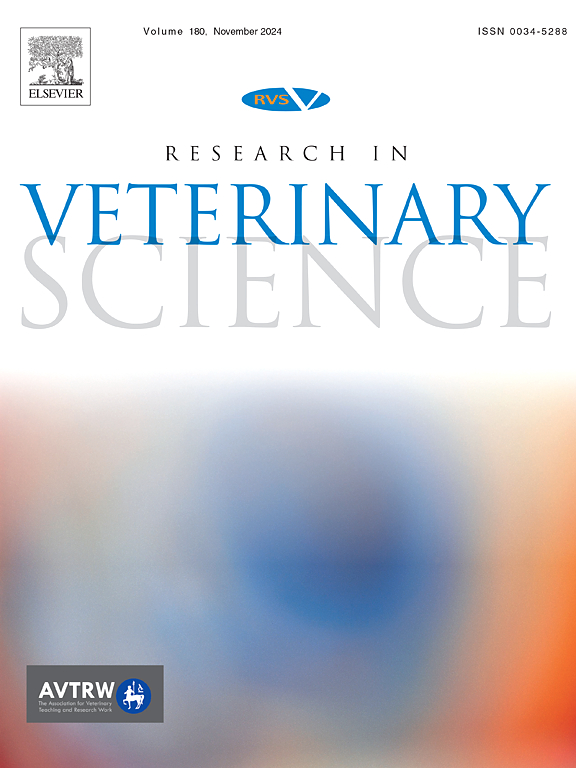Oxidative stress response in avian pathogenic Escherichia coli
IF 2.2
3区 农林科学
Q1 VETERINARY SCIENCES
引用次数: 0
Abstract
Avian pathogenic Escherichia coli (APEC) leads to significant economic losses in the poultry industry worldwide and restricts the development of the poultry industry. Oxidative stress, through the production of reactive oxygen species (ROS), damage iron‑sulfur (Fe![]() S) clusters, cysteine and methionine protein residues, and DNA, and then result in bacterial cells death. APEC has evolved a series of regulation systems to sense and quickly and appropriately respond to oxidative stress. Quorum sensing (QS), second messenger (SM), transcription factors (TFs), small regulatory RNAs (sRNAs), and two-component system (TCS) are important regulation systems ubiquitous in bacteria. It is of great significance to control APEC infection through investigating the molecular regulation mechanism on APEC adapting to oxidative stress. However, how the cross-talk among these regulation systems co-regulates transcription of oxidative stress-response genes in APEC has not been reported. This review suggests exploring connector proteins that co-regulate these regulation systems that co-activate transcription of oxidative stress-response genes to disrupt bacterial antioxidative defense mechanism in APEC, and then using these connector proteins as drug targets to control APEC infection. This review might contribute to illustrating the functional mechanism of APEC adapting to oxidative stress and exploring potential drug targets for the prevention and treatment of APEC infection.
S) clusters, cysteine and methionine protein residues, and DNA, and then result in bacterial cells death. APEC has evolved a series of regulation systems to sense and quickly and appropriately respond to oxidative stress. Quorum sensing (QS), second messenger (SM), transcription factors (TFs), small regulatory RNAs (sRNAs), and two-component system (TCS) are important regulation systems ubiquitous in bacteria. It is of great significance to control APEC infection through investigating the molecular regulation mechanism on APEC adapting to oxidative stress. However, how the cross-talk among these regulation systems co-regulates transcription of oxidative stress-response genes in APEC has not been reported. This review suggests exploring connector proteins that co-regulate these regulation systems that co-activate transcription of oxidative stress-response genes to disrupt bacterial antioxidative defense mechanism in APEC, and then using these connector proteins as drug targets to control APEC infection. This review might contribute to illustrating the functional mechanism of APEC adapting to oxidative stress and exploring potential drug targets for the prevention and treatment of APEC infection.
禽致病性大肠杆菌的氧化应激反应。
禽致病性大肠杆菌(APEC)导致全球家禽业遭受重大经济损失,并制约着家禽业的发展。氧化应激通过产生活性氧(ROS)破坏铁硫(FeS)簇、半胱氨酸和蛋氨酸蛋白残基以及 DNA,进而导致细菌细胞死亡。APEC 进化出了一系列调节系统,以感知氧化应激并迅速做出适当反应。法定量感应(QS)、第二信使(SM)、转录因子(TF)、小调控 RNA(sRNA)和双组分系统(TCS)是细菌中无处不在的重要调控系统。通过研究APEC适应氧化应激的分子调控机制,对控制APEC感染具有重要意义。然而,这些调控系统之间的交叉对话如何共同调控 APEC 中氧化应激反应基因的转录尚未见报道。本综述建议探索共同调控这些调控系统的连接蛋白,这些连接蛋白共同激活氧化应激反应基因的转录,从而破坏 APEC 中细菌的抗氧化防御机制,然后利用这些连接蛋白作为药物靶点来控制 APEC 感染。这篇综述可能有助于说明 APEC 适应氧化应激的功能机制,并探索预防和治疗 APEC 感染的潜在药物靶点。
本文章由计算机程序翻译,如有差异,请以英文原文为准。
求助全文
约1分钟内获得全文
求助全文
来源期刊

Research in veterinary science
农林科学-兽医学
CiteScore
4.40
自引率
4.20%
发文量
312
审稿时长
75 days
期刊介绍:
Research in Veterinary Science is an International multi-disciplinary journal publishing original articles, reviews and short communications of a high scientific and ethical standard in all aspects of veterinary and biomedical research.
The primary aim of the journal is to inform veterinary and biomedical scientists of significant advances in veterinary and related research through prompt publication and dissemination. Secondly, the journal aims to provide a general multi-disciplinary forum for discussion and debate of news and issues concerning veterinary science. Thirdly, to promote the dissemination of knowledge to a broader range of professions, globally.
High quality papers on all species of animals are considered, particularly those considered to be of high scientific importance and originality, and with interdisciplinary interest. The journal encourages papers providing results that have clear implications for understanding disease pathogenesis and for the development of control measures or treatments, as well as those dealing with a comparative biomedical approach, which represents a substantial improvement to animal and human health.
Studies without a robust scientific hypothesis or that are preliminary, or of weak originality, as well as negative results, are not appropriate for the journal. Furthermore, observational approaches, case studies or field reports lacking an advancement in general knowledge do not fall within the scope of the journal.
 求助内容:
求助内容: 应助结果提醒方式:
应助结果提醒方式:


